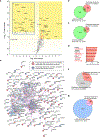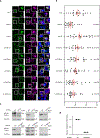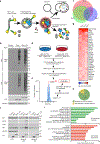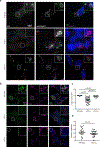The LC3-conjugation machinery specifies the loading of RNA-binding proteins into extracellular vesicles
- PMID: 31932738
- PMCID: PMC7007875
- DOI: 10.1038/s41556-019-0450-y
The LC3-conjugation machinery specifies the loading of RNA-binding proteins into extracellular vesicles
Abstract
Traditionally viewed as an autodigestive pathway, autophagy also facilitates cellular secretion; however, the mechanisms underlying these processes remain unclear. Here, we demonstrate that components of the autophagy machinery specify secretion within extracellular vesicles (EVs). Using a proximity-dependent biotinylation proteomics strategy, we identify 200 putative targets of LC3-dependent secretion. This secretome consists of a highly interconnected network enriched in RNA-binding proteins (RBPs) and EV cargoes. Proteomic and RNA profiling of EVs identifies diverse RBPs and small non-coding RNAs requiring the LC3-conjugation machinery for packaging and secretion. Focusing on two RBPs, heterogeneous nuclear ribonucleoprotein K (HNRNPK) and scaffold-attachment factor B (SAFB), we demonstrate that these proteins interact with LC3 and are secreted within EVs enriched with lipidated LC3. Furthermore, their secretion requires the LC3-conjugation machinery, neutral sphingomyelinase 2 (nSMase2) and LC3-dependent recruitment of factor associated with nSMase2 activity (FAN). Hence, the LC3-conjugation pathway controls EV cargo loading and secretion.
Conflict of interest statement
Figures














Comment in
-
L(C3)icensing of exosomes for RNA export.Nat Cell Biol. 2020 Feb;22(2):137-139. doi: 10.1038/s41556-020-0466-3. Nat Cell Biol. 2020. PMID: 31992866 No abstract available.
-
LC3-dependent extracellular vesicle loading and secretion (LDELS).Autophagy. 2020 Jun;16(6):1162-1163. doi: 10.1080/15548627.2020.1756557. Epub 2020 Apr 24. Autophagy. 2020. PMID: 32330402 Free PMC article.
References
-
- Kaur J & Debnath J Autophagy at the crossroads of catabolism and anabolism. Nat Rev Mol Cell Biol 16, 461–472 (2015). - PubMed
-
- Guo H et al. Atg5 Disassociates the V1V0-ATPase to Promote Exosome Production and Tumor Metastasis Independent of Canonical Macroautophagy. Dev Cell 43, 716–730 e717 (2017). - PubMed
Materials and Methods References
-
- Pear WS, Scott ML & Nolan GP Generation of high-titer, helper-free retroviruses by transient transfection. Methods Mol Med 7, 41–57 (1997). - PubMed
-
- Cox J & Mann M MaxQuant enables high peptide identification rates, individualized p.p.b.-range mass accuracies and proteome-wide protein quantification. Nat Biotechnol 26, 1367–1372 (2008). - PubMed
-
- Tyanova S et al. The Perseus computational platform for comprehensive analysis of (prote)omics data. Nat Methods 13, 731–740 (2016). - PubMed
-
- Thery C, Amigorena S, Raposo G & Clayton A Isolation and characterization of exosomes from cell culture supernatants and biological fluids. Curr Protoc Cell Biol Chapter 3, Unit 3 22 (2006). - PubMed
Publication types
MeSH terms
Substances
Grants and funding
- R21 CA201849/CA/NCI NIH HHS/United States
- R01 GM123977/GM/NIGMS NIH HHS/United States
- R01 CA240984/CA/NCI NIH HHS/United States
- K12 GM081266/GM/NIGMS NIH HHS/United States
- R01 CA188404/CA/NCI NIH HHS/United States
- R01 AG057462/AG/NIA NIH HHS/United States
- R00 CA194077/CA/NCI NIH HHS/United States
- F30 CA224693/CA/NCI NIH HHS/United States
- R01 CA213775/CA/NCI NIH HHS/United States
- T32 CA108462/CA/NCI NIH HHS/United States
- F31 CA217015/CA/NCI NIH HHS/United States
- R01 CA226851/CA/NCI NIH HHS/United States
- K08 CA184116/CA/NCI NIH HHS/United States
- T32 GM007618/GM/NIGMS NIH HHS/United States
- R01 CA126792/CA/NCI NIH HHS/United States
LinkOut - more resources
Full Text Sources
Other Literature Sources
Molecular Biology Databases
Research Materials
Miscellaneous

